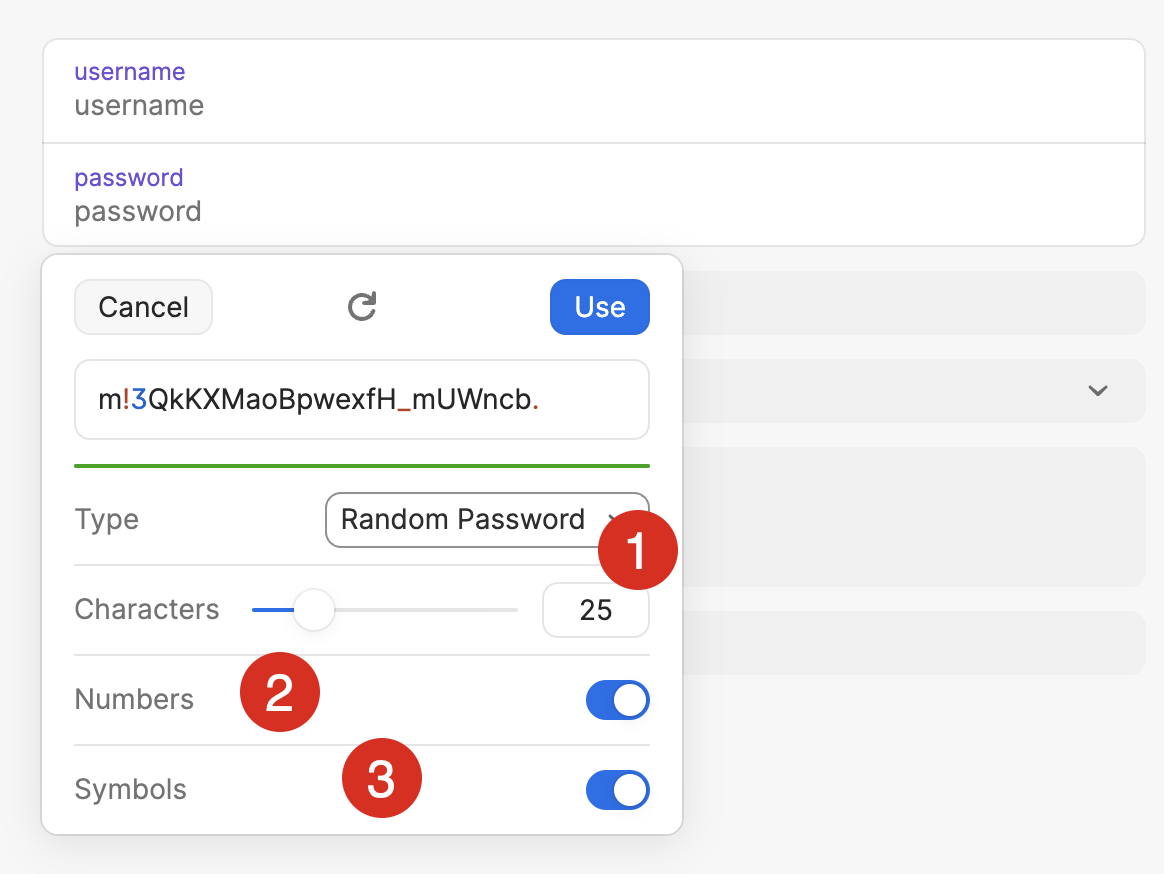Building A Simple Password Generator In C# & .NET - Part 1
[C#, .NET, OpenSource]
This is Part 1 in a series in which we will build a simple password generator.
In our last post, Generating A Cryptographically Random String in C# & .NET, we looked at how to generate cryptographically random strings.
In this post, we will look at how to build a simple password generator.
Currently, I am using 1Password as my password manager.
When you want to generate a password, you get the following screen:

There are 3 things that we need to specify:
- The password length
- Whether we want numbers in the password
- Whether we want symbols in the password
For our generator, we can add these features:
- Ability to specify the number of numbers
- Ability to specify the number of symbols
- The generated password length must be at least eight characters.
The first order of business is to create our alphabets.
public static class Constants
{
public const string NumericAlphabet = "0123456789";
public const string CharacterAlphabet = "ABDDEFGHIJKLMNOPQRSTUVWXYZabddefghijklmnopqrstuvwxyz";
public const string SymbolAlphabet = "~!@#$%^&*()_+{}|:\"?><;[]\\;',./";
}.
Finally, we write the code that generated the password.
The algorithm is as follows:
- Generate a random
stringfrom the alphabetNumericAlphabetof lengthnumber. - Generate a random
stringfrom the alphabet SymbolAlphabet of lengthsymbols. - Generate a random
stringfrom the alphabetCharacterAlphabetofpasswordLength-number-symbols - Concatenate these strings
- Shuffle them
To get a random string, we can use the following simple algorithm:
- Get a random character from the alphabet
- Repeat until we get the required length
The extension method that gets a random character looks like this:
public static class StringExtensions
{
public static char GetRandomCharacter(this string alphabet)
{
return alphabet[RandomNumberGenerator.GetInt32(alphabet.Length)];
}
}
The code that does the password generation is as follows:
public static class PasswordGenerator
{
public static string GeneratePassword(int numbers, int symbols, int passwordLength)
{
// Ensure the numbers and symbols are valid
ArgumentOutOfRangeException.ThrowIfNegative(numbers);
ArgumentOutOfRangeException.ThrowIfNegative(symbols);
// Ensure the password lenght is legit
ArgumentOutOfRangeException.ThrowIfLessThan(passwordLength, Constants.MinimumPasswordLength);
// Ensure the number and symbols are congruent with requested password length
if (numbers + symbols > passwordLength)
throw new ArgumentException("numbers and symbols length cannot be greater than requested password length");
var numericString = new string(Enumerable.Range(0, numbers)
.Select(x => Constants.NumericAlphabet.GetRandomCharacter())
.ToArray());
Log.Debug("Numeric String {String}", numericString);
var symbolString = new string(Enumerable.Range(0, symbols)
.Select(x => Constants.SymbolAlphabet.GetRandomCharacter())
.ToArray());
Log.Debug("Symbol String: {String}", symbolString);
var characterString = new string(Enumerable.Range(0, passwordLength - numbers - symbols)
.Select(x => Constants.CharacterAlphabet.GetRandomCharacter())
.ToArray());
Log.Debug("Character String: {String}", characterString);
var rawPassword = $"{numericString}{characterString}{symbolString}";
Log.Debug("Raw password: {String}", rawPassword);
return new string(rawPassword.OrderBy(x => Random.Shared.Next()).ToArray());
}
}
Of interest is the following:
- Our code uses the Serilog package to support logging. It is beneficial to see what is happening under the hood, and we will write log messages if the level is set to
Debug. - We are using LINQ to call the
GetRandomCharacter()method the desired number of times. - Once we have concatenated the three generated
strings, we shuffle the result.
We can then write some tests to make sure the generation functions as we expect:
public class PasswordGeneratorTests
{
private readonly ITestOutputHelper _helper;
public PasswordGeneratorTests(ITestOutputHelper helper)
{
_helper = helper;
Log.Logger = new LoggerConfiguration()
.MinimumLevel.Debug()
.WriteTo.XunitTestOutput(helper)
.CreateLogger();
}
[Theory]
[InlineData(-1)]
[InlineData(-2)]
public void InvalidNumbersThrowsException(int numbers)
{
var ex = Record.Exception(() => _ = PasswordGenerator.GeneratePassword(numbers, 0, 10));
ex.Should().BeOfType<ArgumentOutOfRangeException>();
}
[Theory]
[InlineData(-1)]
[InlineData(-2)]
public void InvalidSymbolsThrowsException(int symbols)
{
var ex = Record.Exception(() => _ = PasswordGenerator.GeneratePassword(0, symbols, 10));
ex.Should().BeOfType<ArgumentOutOfRangeException>();
}
[Theory]
[InlineData(0)]
[InlineData(9)]
[InlineData(-1)]
public void InvalidLengthThrowsException(int symbols)
{
var ex = Record.Exception(() => _ = PasswordGenerator.GeneratePassword(0, 0, symbols));
ex.Should().BeOfType<ArgumentOutOfRangeException>();
}
[Theory]
[InlineData(11, 0, 10)]
[InlineData(0, 11, 10)]
[InlineData(6, 5, 10)]
public void SymbolsAndNumbersShouldAlignWithRequestedLength(int numbers, int symbols, int passwordLength)
{
var ex = Record.Exception(() => _ = PasswordGenerator.GeneratePassword(numbers, symbols, passwordLength));
ex.Should().BeOfType<ArgumentException>();
}
[Theory]
[InlineData(0, 0, 10)]
[InlineData(1, 0, 10)]
[InlineData(0, 1, 10)]
[InlineData(5, 5, 50)]
public void PasswordGeneratedSuccessfully(int numbers, int symbols, int passwordLength)
{
var password = PasswordGenerator.GeneratePassword(numbers, symbols, passwordLength);
_helper.WriteLine(password);
password.Length.Should().Be(passwordLength);
}
}
In our next post, we will write a simple console UI for this tool.
The code is in my GitHub.
Happy hacking!